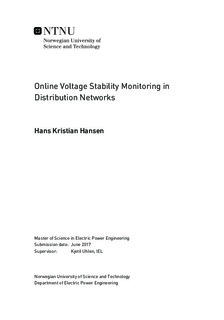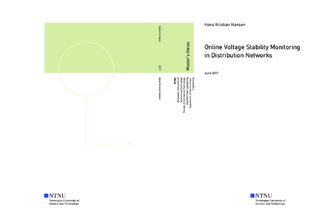| dc.description.abstract | Power systems are often operated close to their stability limit. Line contingencies or other disturbances can cause the system to lose stability. If the power system loses stability counteractions have to be taken or else interruption in parts of, or in the whole system, occurs. In order to identify operational limits, the system operator needs the appropriate tools to make counteractions towards maintaining the security of operation.
Phasor measurement unit utilization has great potential for improved situational awareness in power system operation. This thesis assesses three indicators to monitor voltage stability in real time. All indicators are composed of changes in power with respect to changes in load. The indicators are based on local phasor measurements at the load bus, meaning no information about the topology is taken into account. In addition, two methods for estimating the Thevenin impedance and accordingly the maximum power transfer are reviewed. The methods and the indicators are suitable for online implementations to visualize the current state of the system and the distance to voltage instability.
Experiments realized through a laboratory power system consisted of a coil, a flexible line equivalent, a transformer and an adjustable resistive load. The scenarios the system was exposed to was an increase in load power demand and a line contingency. MATLAB simulations beforehand illustrate the theoretical behavior of the laboratory experiments.
As the indicators are able to detect the maximum power transfer limit, the trajectories visualizing the indicators will be of great benefit for the grid operators to identify the distance to the stability limit of the power system. As a large disturbance results in a severe change in power, the indicators need proper filtering depending on the desired monitoring. The estimation of the Thevenin impedance was validated and is corresponding with the calculated system impedance based on laboratory components. Nevertheless, the methods and indicators are viable for practical implementations in power systems to have an online voltage stability monitoring. | |

